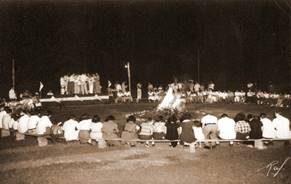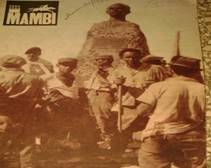My SciELO
Services on Demand
Article
Indicators
-
 Cited by SciELO
Cited by SciELO
Related links
-
 Similars in
SciELO
Similars in
SciELO
Share
EduSol
On-line version ISSN 1729-8091
EduSol vol.22 no.78 Guantánamo Jan.-Mar. 2022 Epub Jan 11, 2022
Articles
Symbols of the University of the East: 1947-1959
1Universidad de Oriente. Santiago de Cuba. Cuba.
The study of university symbols should be the focus of existing educational-communicative projects; however, the management of knowledge and information of the symbols of the Universidad de Oriente requires further communication and interpretation by university audiences. The qualitative methodology used on the basis of the hermeneutic paradigm identified the historical and cultural contexts that gave rise to the symbols. The historical-logical method and the understanding of the principle of identity and the systematization of knowledge made it possible to provide the register of symbols of the University of the East in its initial stage from 1947-1959.
Key words: Symbols; Universities; Universidad de Oriente; Identity
Introduction
Symbols are part of the history of peoples and organizations, they express significant events and are bearers of identity. Their study is not a simple matter of erudition; it is linked to the knowledge that men have of themselves, it answers the following questions: who we are, where we come from and where we are going, in order to ensure that the values they represent are perpetuated in time. And it contains the vast scope of possibilities in continuous extension and allows the perception of the fundamental relationships between forms, contents, discourses and modalities.
Nowadays, universities occupy spaces for reflection and action that are increasingly oriented towards the identification, recognition and communication of their symbols. They have become reservoirs of tangible and intangible assets that attest to the continuous historical, academic, scientific, extension and cultural processes that take place there. Exceptional buildings for their architecture, movable goods of diverse nature: artistic, scientific, documentary, monuments, customs, rites and traditions, compose, among others, the diversity of treasured symbols.
The university is tangible and at the same time a state of mind; it is real and imagined, it has its own historical path, but it also points out the paths of its environment; it is a symbol of tradition and renewal at the same time; of accentuated traditions and revolutionary conflicts; of inquisitive youth and meditative maturity. (Felipe, 2015, p.74)
The symbolic construction in the context of higher education centers has a lot to do nowadays with information, the type of discourse, culture, the generation of knowledge and the transfer of this information through messages that promote a coherent perception of reality.
The symbolic becomes an essential factor for decision making and acceptance of knowledge programs generated in educational institutions where the processes of the global system are increasingly incorporated into the local scale and puts many communities in the dilemma between resilience and resistance to these new schemes of scientific knowledge production. It is a social process that has to do with knowing and sharing the history, vision, mission, objectives, goals and everything that shapes identity.
To a greater or lesser extent, we have reduced these university symbols to museum pieces, because university students have not been taught to give them another value and to look at them from another perspective. Hence, some have confined them to oblivion and, although they often have them in sight or hear them, they do not perceive them consciously: to our misfortune, some have them in the basement of the unconscious. (Álvarez, 2005, p. 75)
The bibliographic review revealed that several universities around the world, based on their quality educational concept, respectful of legal and regulatory structures, seek to establish official standards to define the design, characteristics, uses, dissemination, application and preservation of the symbols that distinguish them. Among them is the Autonomous University of the State of Mexico (UAEM), which since 2006 approved the Regulation of the University Symbols, where it is stated that from a historical perspective, the symbols fulfill a duality; on the one hand, they characterize the institutional work, and on the other hand, they are elements that nurture and strengthen the identity of the members of the institution.
Also from Mexico, the Autonomous University Juárez of Tabasco (UJAT) on July 7, 2011 approved in Extraordinary Session by the Honorary University Council the Regulation on the representative symbols of the UJAT, which highlights the need to link the meaning and representation of the symbols with the historical moments through which this house of higher education has passed.
And in Europe, the Spanish University Arturo de Michilena stands out, which in use of the powers conferred by the Law of Universities and the Organic Statute of the University dictated in the session No. 67 of the University Council, on July 25, 2012 the Instructive on the use, dissemination and preservation of the name, acronym, symbols and emblems, where it is stated that these elements represent the moral, spiritual and intellectual conception of the university institutionality; and therefore are part of its cultural heritage.
As Álvarez (2005) refers, there are still many universities where the promotion of their symbols does not take place with due dynamics. In this sociocultural dimension, it should be noted that the communication of university symbols requires that they have a common meaning and are consistent with the strategic objectives of protecting the entire historical memory, as well as to support the new generation of scientific knowledge based on the experience and experiences of the past and present with a vision of the future.
The University of the East treasures a cultural and communicational symbolic repertoire of tangible and intangible character that has helped it to enhance its national and international reputation. However, it is still insufficient the domain of its limits, particularities and scope, which prevents the visibility and interpretation of its meanings for the university community; from the objective of continuing education of professionals and the appropriate use of the media. Hence, the study presented here aims to determine the register of symbols of the University of the East in the 1st stage: 1947-1959.
The management of the knowledge of symbols, their proper interpretation and media use is essential for the training of current generations of university professors and students. University symbols contain historical and cultural contents, but they also express national identity. Their meanings are an expression of generational continuity and of the values of a social system that presents and represents them.
Development
Register of the symbols of the University of the East: 1947-1959
Central Building
From the very beginning, the University of the East was identified through the image of the Central Building (Figure 1). This construction of simple eclectic influence had a square floor plan and two stories, with a structure of masonry and brick walls, a mezzanine of wooden beams and the presence of an entablature. In 1949, it underwent intense remodeling and construction work to adapt it to the new needs of an educational institution. The work was directed by engineer Joaquín Vázquez Alvarado.
In May 1949, work was carried out to adapt the premises for classrooms adapted to teaching: drawing classrooms, some were used as laboratories, others for general education, and the Library was temporarily located on the second floor. The Chamber of Commerce and the Aponte Club donated money to the University and thanks to the help received at that time; the University was able to continue with the expansion and completion of the building.
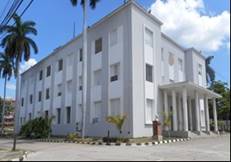 Source. Application for declaration as a national monument of the University of the East, 2018.
Source. Application for declaration as a national monument of the University of the East, 2018.Figure 1: View of the first central building.
On March 31, 1950, the offices of the General Secretariat, the Department of Cultural Relations and the Library were moved from the Professional School of Commerce, as well as all the schools, except for the School of Commercial Sciences, which would be moved the following year. In the same year, the Natural History Museum, the Archeology and History Museum, the Geography Department and the Art History Museum were to be installed in the same building.
The projects for a third floor over the two lateral naves and for the reform of the facades of this building were commissioned to the architect Rodulfo Ibarra Pérez and approved by the then Rector of the University of the East, Felipe Salcines Morlote.
These works were executed by the contractor Serapio Prats Orta and involved the consolidation of the existing building, the reinforcement of the foundation and the inclusion of reinforced concrete columns, slabs and beams. The proposed language was Monumental Modern, the architectural response of the time to social and official issues, expressed in the emphasis of the access through the central staircase and the roofed volume supported by circular columns of great slenderness that emphasize the main facade of the building, which is topped at the top with the coat of arms of the institution.
On April 30, 1952, the preliminary project for the beautification of the front and side facades was approved, and by this date it was also agreed to prepare a facade project for the building. After successive reconstructions, the current façade was acquired and the emblem of the University, carved in two pieces, was attached to it. Thus was born, as far as architectural construction is concerned, the High House of Studies of Santiago de Cuba.
On both sides of the central body there are two volumes lacking in decoration, the framed windows cover the three levels, in which their sober design stands out and which reinforce the symmetry of the main façade. On the side facades, the solution of the fenestration elements marks a regular rhythm, although they are presented in isolation.
This building is dominated by pure volumes and sharp edges, which place it within the canons of Santiago's modernity. The surroundings of the building were provided with wide sidewalks, a task developed by a team of public works, which was ceded by Mayor Luis Casero Guillén, thus becoming the flagship building of the Universidad de Oriente, not only for having been the first but because it would be the heart of the nascent center of higher education.
En 1952 el edificio contaba con: en el primer nivel, la Administración de la Escuela de Verano, la Sala de Profesores, la Oficina del Departamento de Psicología, los Laboratorios de Química Orgánica, Inorgánica y Analítica, el Laboratorio de Física, el Laboratorio de Química-Física, las aulas del curso de Derecho, así como los Laboratorios de Química y el almacén de suministros.
En el segundo nivel se encuentran las aulas de los cursos de Derecho, Filosofía y Ciencias Comerciales, el curso preuniversitario de la Facultad de Educación, la oficina de la Secretaría General, el Laboratorio de Investigación Química José Luis Casaseca y la oficina del Departamento de Actividades Sociales y Publicidad.
On the third level were located: the School of Engineering, the Language Institute, the Philosophy and Law departments, the Museum of Archeology and History of Cuba, the Museum of Natural History and the premises of the Federation of University Students of the East (FEU-O). At present, the building houses the Faculties of Law, Natural and Exact Sciences, the Museum of Natural Sciences, the printing press and the Meteorology Department.
Coat of arms of the University of the East
University of the East, since its foundation, took the first steps to define its emblems and distinctive emblems. In order to achieve both national and international recognition of this eastern institution and achieve a greater sense of belonging of the student body with the educational center Pedro Cañas Abril, Dean of the Faculty of Philosophy and Education, Francisco Prat Puig, Professor of Art History and Max E Figueroa were in charge of designing some of the elements that would have the mission of representing the new Cuban university.
Figure 2: Coat of arms of the University of the East
It was intended to represent the environment in which this academic center was located (Figure 2). The design of the emblem was discussed in group and finally Francisco Prat Puig was commissioned to make the drawing. It clearly outlines not only the pedagogical, but also the general and all-encompassing objective of the oriental institution. The motto Science and Conscience reflected the projection of the University of the East.
Science and Conscience. This is, in synthesis, the soul of our University. We cultivate knowledge, research, technique, the values of intelligence; but we cultivate at the same time ethics, aesthetics, civics, the values of the heart without which man does not acquire human quality. Science and Conscience! This is how we want our University to always be: Science and Conscience (Cañas, 1953, p.14).
The idea arose, as Cañas (1972) refers, from a book written by an Argentine pedagogue; Science and Conscience of Education. "Since it was necessary to adopt a motto for the university, I proposed that it should be Science and Conscience, because such a motto represented not only a phrase, but a program, a position, and it was finally accepted unanimously" (Cañas, 1972, p.205). (Cañas, 1972, p.205) Thus the coat of arms became one of the main symbols around which the life of the University of the East has revolved.
University Choral
Juan Viccini was the one who took on the challenge of forming the University Choir in 1950 (Figure 3). Among its founding students were: Electo Silva Gaínza; Carlos Amat Forés, Juan Escalona Reguera; Alba Griñán Nuñez, Thalía Fung Riverón; Delfina Yero Gil and Vilma Espín Guillois.
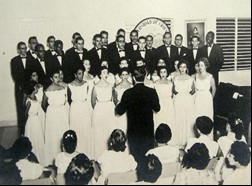 Source: Historical archive of the Universidad de Oriente
Source: Historical archive of the Universidad de OrienteFigure 3: The University Choir at the end-of-year party, 1955.
The Chorale played a leading role in the main activities that took place within the university campus: graduations, parties, commemorations, acts of remembrance and patriotic dates. On April 3, 1951, they received a visit from the Yale University Chorale, with which they fraternized and exchanged numbers from the repertoires of both groups. "The University Chorale would play an important role in the development and promotion of such music in the city. Groups such as the Coro Madrigalista and the Orfeón Santiago have been its most worthy heirs" (File for Declaration as National Monument of the University of the East, 2018.p.38).
On February 28, 1960, in the Cathedral of Santiago de Cuba, and with the presence of outstanding personalities of the national culture, as is the case of Alejo Carpentier, the music of Esteban Salas is interpreted for the first time with the participation of the University Choir.
Francisco Martínez Anaya Central Library
The Central Library of the University of the East (Figure 4) was designed by architect Rodulfo Ibarra Pérez and inaugurated in 1951. Initially it was a single-story building, and during the construction process the same architect designed a second level. It has a reinforced concrete skeleton structure and responds to the Protorracionalist style.
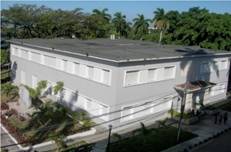 Source: File for Declaration as a National Monument of the University of the East.
Source: File for Declaration as a National Monument of the University of the East.Figure 4: Central Library
In its historical development it can be mentioned that in the halls of the Central Library, on September 17, 1951, the academic year 1951-1952 was inaugurated; in December 1952 it was agreed to designate it as Francisco Martínez Anaya, unveiling a plaque with that name on January 25, 1953, to honor the memory of the man who was the first Dean of the School of Law and Commercial Sciences, whose funeral was held in this building. The Library has had several functions: as a Reading Room, Lecture Hall, Conference Room, and Friendship Meetings between several countries and inauguration of Exhibitions. Today it is the center of several courses, academic, scientific and research events.
Among the most important historical events that have taken place in the main hall are: the constitution and functioning of the First Cuban Revolutionary Government; the funeral of the remains of the university martyr Eduardo Mesa Llul, which symbolized the homage of this house of studies to its martyrs and, more recently on October 4, 2017, the founding of the Honorary Chair for the Study of the thought and work of Fidel Castro Ruz.
Playground and Mambisa Campfire
Since the founding of this higher education center in the eastern part of the country, the importance and responsibility of Physical Education to form apt and capable individuals in the development of habits and skills in relation to their physical and mental health remained. This is reflected in Article 8 of its statutes: "The Universidad de Oriente will watch with all zeal over the Moral and Civic Education of its students, and will also provide them with the Physical Education necessary for individual health" (Statutes of the Universidad de Oriente, 1947, p.37).
The Mambisa Campfire was inaugurated on October 22, 1952 (Figure 5). Throughout this period, the Campfield has been the scene of the main university activities, where graduations, solemn acts in remembrance of historical dates, cultural and sports festivals, as well as various recreational activities have been held. It was the center for the military training of the University Mambi Militias and one of the fundamental sites for Fidel Castro Ruz and Ernesto Che Guevara to hold meetings with the neighbors of the area and the university community. It also became the scene of one of the university traditions that became a symbol of that period, the Mambisa Bonfire (Figure 6), which took place at the end of each of the activities that took place there.
Emblem of the Mambises Sports Games
In the early fifties, the first university sports teams began to emerge, and students became interested in acquiring a name that would identify them for the purposes of sports competitions. Some of them were valued, among them the Siboneyes, but many did not agree with this name. Gil de las Casas, one of the students of the Industrial Chemistry course, proposed Mambises, because it was the name of the Liberator Army in the anti-colonialist struggle for the independence of Cuba.
Mambises was the adjective chosen to represent the characteristics of the university force, it was a symbol of the oriental student body since the very foundation of the Center and it evidenced the indomitable character of the young people of this part of the country. The graphic representation of the name assumed is the Mambí on the Horse with the Machete and it is an element that became an identifying symbol of the institution, as a representative image of the university sports games, reason why inside and outside the center the faculties assumed this attribute to identify themselves in the competitions (figure 7).
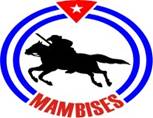 Source: Historical Archive of the Universidad de Oriente
Source: Historical Archive of the Universidad de OrienteFigure 7: Emblem of the Mambises Sports Games.
Banners with the symbol of the Mambí at the top on a background that had the same color of the faculty in competition were taken to the games. These allegories presided over the friendly matches between university athletes. With the creation of new faculties, a representative color was designated for each one of them, always looking for a relationship between the chromatic and the different knowledge that integrates each specialty, in order to achieve a better identification in the university games, as well as in other teaching and extracurricular activities.
Mambí Magazine
At the end of 1952 and beginning of 1953, the confrontation of university students with the repressive government of Fulgencio Batista worsened. In response to this, in January 1953 and in order to guarantee a better communication with the student body and the general public, the first issue of the Mambí Magazine was published, an organ of dissemination of the FEU-O (Figure 8).
It was dedicated to José Martí in the year of his centenary. It reflected the problems existing in Cuba and the need to get rid of Batista's tyranny, in addition to disseminating Martí's ideas. It served to transmit the new ideas that encouraged the eastern university students, its slogan was: With Cuba and for Cuba without dictatorships.
It became the faithful exponent of the university students' feelings, who, evidently, were immersed in the struggle against the dictatorship and the political and social instability of the country, which was reflected in the repeated suspensions of teaching activities. "With this magazine a new revolutionary trench begins, a new front of combat against reaction is opened, a new vehicle of expression is offered to the Cuban sentiment, to the sentiment of the national and humanist revolution" (Cañas, 1972, p.205).
At the beginning of 1957, the University closed its doors as a consequence of the tyranny's pressure due to the critical political situation, and the magazine ceased to be published. With the revolutionary triumph of 1959, a new edition would come out, publishing the work of the University Student Federation (FEU) within the Cuban Revolution.
The Revista Mambí was the continuation of the initial bulletin that had been published during the republican period. Due to the function it developed in the historical period in which it came to the public arena and within which it subsisted, it played a fundamental role in the defense of student interests, forming patriotic values and a sense of duty to the future of the nation.
Rectorate Building
At the end of the 1950s, the University of the East still did not have all the premises for the location of its teaching and service activities, many of which were distributed among the few areas that existed, without adequate conditions; others were located in areas far from the University. In order to provide a solution to these needs, the construction of the building identified as the Rector's Office was proposed (Figure 9).
 Source: Department of Communication. Institutional of the University of the East
Source: Department of Communication. Institutional of the University of the EastFigure 9: Rectorate Building
The project was carried out in 1956 by the architects Eduardo Cañas Abril and Nujím Nepomechie, who also conceived the general plan: parking areas and gardens. The construction of the work was awarded to the construction firm Serapio Prats e hijos, and the time for its execution was estimated at 18 months. That same year the construction of its foundations began. In 1959 the building was still under construction, but it was used for the main purposes of the center of higher studies as its facilities were partially completed, until it was finished in 1960.
Conclusions
Institutions of higher education, especially the most long-lived ones, possess an extraordinary symbolic richness, the understanding of which is indispensable for all university students. The knowledge, information and mastery of the meaning of university symbols is of great significance for generational continuity and the application of training programs and strategies for professionals and for the use of university audiences in different historical and social contexts.
The registry of the symbols of the University of the East that is provided constitutes an informative processing of updating that serves to identify and represent it in the different national and international spaces in which it performs; it is also a communicative expression of the cultural language of the institution. They reflect the history, traditions and values of the center; that is to say, they synthesize its identity according to the philosophy of maintaining a sense of belonging that is projected in its educational-communicative and internationalization strategies.
Referencias bibliográficas
Álvarez, B. (2005). Símbolos, valores, realidades y expectativas de nuestra identidad universitaria. Una mirada desde el arte y las humanidades. La Colmena. No. (45), pp.73-85. http://www.redalyc.org/articulo.oa?id=446344894011 [ Links ]
Cañas, P. (1953). Investidura de los primeros graduados. Extensión y relaciones culturales, (29). Santiago de Cuba: Ediciones de la Universidad de Oriente. pp. 9-23. [ Links ]
Cañas, P. (1972). El año XXV. Santiago, (8). Ediciones de la Universidad de Oriente. pp. 199-220. [ Links ]
Felipe, C. (2015). Al abrigo del Alma Mater. Patrimonio cultural universitario: valores y experiencias de gestión desde la Universidad de La Habana;Tesis Doctoral, Universidad de Granada. https://hera.ugr.es>tesisugr [ Links ]
Universidad Autónoma del Estado de México. (2006). Reglamento de los Símbolos Universitarios. https://www.uaemex.mx [ Links ]
Universidad Española Arturo de Michilena. (2012). Instructivo sobre el uso, difusión y preservación de la denominación, siglas, símbolos y emblemas. https://www.uaem.edu.ve [ Links ]
Universidad Juárez Autónoma de Tabasco (2011). Reglamento sobre los símbolos representativos de la UJAT https://www.archivos.ujat.mx [ Links ]
Universidad de Oriente. (1947). Estatutos de la Universidad de Oriente [ Links ]
Universidad de Oriente. (2018). Expediente para Declaratoria como Monumento Nacional. Archivo de la Secretaría General de la Universidad de Oriente. [ Links ]
Received: March 15, 2021; Accepted: July 05, 2021











 text in
text in 


